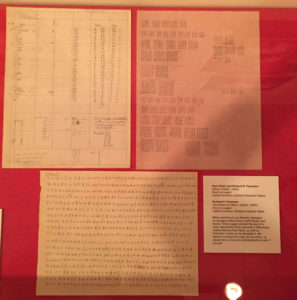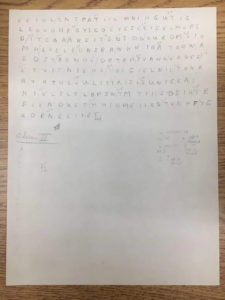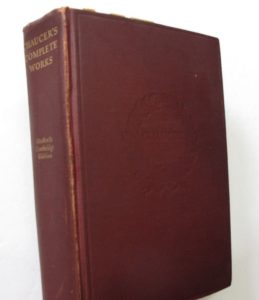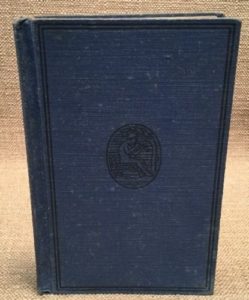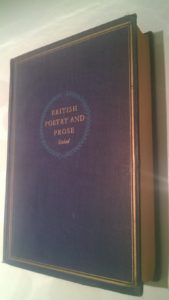Wonderful news – a long-standing cipher mystery (to be precise, a pair of them) has been broken!
Today I received a message from David Vierra announcing that he had broken Feynman Ciphers #2 and #3, and including a link to his blog post including all the technical details. He noted:
They both use the same method, which uses two monoalphabetic substitutions and alternates between them after each word. Each word which has an even number of letters is written in reverse. Cipher #2 is from A.E. Housman’s poem “Terence, This is Stupid Stuff”, and #3 is the starting words of Feynman’s own paper on “Atomic Theory of the lambda Transition in Helium”.
So, let’s have a closer look:
Feynman Cipher #2
Here’s the ciphertext:
XUKEXWSLZJUAXUNKIGWFSOZRAWURORKXAOSLHROB
XBTKCMUWDVPTFBLMKEFVWMUXTVTWUIDDJVZKBRMC
WOIWYDXMLUFPVSHAGSVWUFWORCWUIDUJCNVTTBER
TUNOJUZHVTWKORSVRZSVVFSQXOCMUWPYTRLGBMCY
POJCLRIYTVFCCMUWUFPOXCNMCIWMSKPXEDLYIQKD
JWIWCJUMVRCJUMVRKXWURKPSEEIWZVXULEIOETOO
FWKBIUXPXUGOWLFPWUSCH
To decipher this, use one of the two following cipher alphabets:
Plain: ABCDEFGHIJKLMNOPQRSTUVWXYZ
Alphabet 1: MANYREQUS.HVBCID.OLWGZX.K.
Alphabet 2: JHAZTENYXMLOCUFBQVKPSGW.D.According to David’s blog post:
The first word of each sentence (or line of poetry) is always enciphered using Alphabet 1, which leads to occasional cases of Alphabet 1 being used for two words in a row. Words having an even number of letters are written in reverse.
OK, so let’s try the first line as a worked example:
XUK — EX — WSL — ZJUAXUN — KIG — WFSOZ — RA
[1] WHY — [2] FI — [1] TIS — [2] DANCING — [1] YOU — [2] WOULD — [1] EB
Note that the two even-length words here are FI (if) and EB (be), which is why they’re reversed. Continue with this process for the rest of Feynman Cipher #2 and you get a section from A. E. Housman’s “Terence, This is Stupid Stuff” (1896):
Why, if ‘tis dancing you would be,
There is [sic] brisker pipes than poetry.
Say, for what were hop-yards meant,
Or why was Burton built on Trent?
Oh many a peer of England brews
Livelier liquor than the Muse,
And malt does more than Milton can
To justify God’s ways to man.
Ale, man, ale’s the stuff to drink
For fellows whom it hurts to think
Feynman Cipher #3
The ciphertext here looks like this:
WURVFXGJYTHEIZXSQXOBGSVRUDOOJXATBKTARVIX
PYTMYABMVUFXPXKUJVPLSDVTGNGOSIGLWURPKFCV
GELLRNNGLPYTFVTPXAJOSCWRODORWNWSICLFKEMO
TGJYCRRAOJVNTODVMNSQIVICRBICRUDCSKXYPDMD
ROJUZICRVFWXIFPXIVVIEPYTDOIAVRBOOXWRAKPS
ZXTZKVROSWCRCFVEESOLWKTOBXAUXVBAs David Vierra discovered, this was enciphered using exactly the same method and alphabets as #2, yielding cleartext from near the top of Richard Feynman’s 1953 paper on liquid helium:
The behavior of liquid helium, especially below the lambda transition, is very curious. The most successful theoretical interpretations so far have been largely phenomenological. In this paper and one or two to follow, the problem will be studied entirely from first principles.
So… Who Was The Encipherer, Then?
The cipher system itself is a pretty sadistic combination of substitution (multiple cipher alphabets) and transposition (reversing even-length words), so you can bet that the person who devised it was chortling really hard into their hand when they passed it to Richard Feynman.
Also, Feynman only started working with liquid helium once he moved to Caltech (and started to get his physics mojo back somewhat, after a very difficult period in his life): and I further think it would be unlikely that the encipherer would have enciphered this prior to 1953.
The person who originally posted the set of three ciphers to Reddit (Chris Cole) had noted:
When I was a graduate student at Caltech, Professor Feynman showed me three samples of code that he had been challenged with by a fellow scientist at Los Alamos and which he had not been able to crack.
People had generally parsed this as “had been challenged with by a fellow scientist [while both were] at Los Alamos” in the 1940s, but now we know that the third challenge cipher of this set could not have been made before 1953, I think we should probably instead parse it as “had [recently] been challenged with by a fellow scientist [who, like Feynman, had been] at Los Alamos“.
The two Olum ciphers (that were cracked by Paul Relkin, who also invested a lot of time trying to find the exact edition of Chaucer used as the plaintext for Feynman Cipher #1, which in fact Relkin found out in 2017 had been from one transcribed in the 1930s by F. N. Robinson) were from Paul Olum to Richard Feynman: Feynman’s notes on these ciphers are in his Caltech papers.
With part of Feynman’s 1953 paper as the plaintext to cipher #3 and its wrapper story handed down by Chris Cole, there seems little doubt that this is indeed a set of challenge ciphers targeted specifically at Feynman, just as Feynman had said to Cole. By way of contrast, it seems likely that the original Olum ciphers (from the August 1943 date of the plaintext) were made between August 1943 and 1945.
But was it Paul Olum, as I speculated back in 2021, who was also behind this other set of three ciphers? The problem is that the Chaucer link in Feynman Cipher #1 seems not to point directly at Olum (because his son said he had a different edition of Chaucer); the Housman poem in #2 doesn’t obviously point anywhere; while the 1953 Feynman quotation in #3 points only at the recipient, not at the sender.
My belief is that the Housman poem was probably discussed by Feynman and the encipherer while at Los Alamos, making the reference to it more of a private joke than anything public we can use as a reference.
Ultimately, I think it’s safe to say that Paul Olum remains our strongest candidate, even though we lack evidence. Though… if one day someone happens to look at Olum’s Cornell papers from (say) 1953-1954 and notices a mention of liquid helium and some cipher-like writing, perhaps we will find our smoking gun. Fingers crossed!
Finally, my hearty congratulations once again to David Vierra for his excellent work cracking #2 and #3, well done!
